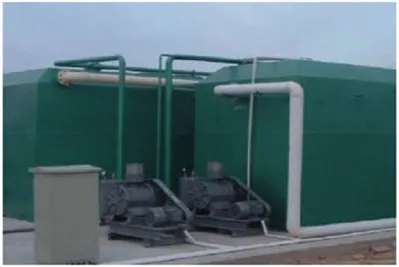We are reputed brand in the industrial market as leading Electrocoagulation Water Treatment Suppliers in India. Coagulation is a common practice in water and wastewater treatment processes. This process is often used prior to filtration or sedimentation. Particles in the solution have a difficult time settling due to their common charges, which cause them to repel from one another. To combat the repellent forces, the charges of the particles must be neutralized so that the colloids will cling together and precipitate. This is an ideal condition for sedimentation and filtration post treatment.

In order to induce coagulation, one of two methods can be used: chemical coagulation or electrocoagulation water treatment. Chemical coagulation has commonly been used in years past, but has a number of unwanted side effects. More recently, electrocoagulation (EC) has been recognized for its effective treatment in many sectors.
Treatment water often contains several different types of contaminants at the start of the treatment process. Heavy metals, organic compounds, pesticides, and colloidal solids can be found, among others. Some treatment methods use multiple systems, to remove this many contaminants. However, EC is able to remove them in a single system with sometimes only a single pass.
Unlike chemical coagulation, which produces high volumes of hazardous sludge, EC produces very little sludge and it is non-hazardous. Because pH adjustment is the only aspect of EC that necessitates the addition of chemicals, there is little to add to the volume of any sludge produced. Also, even though most of the electrodes are sacrificial, they do not oxidize at a rate that would add significant amounts to the sludge.
On the hazardous side of the sludge coin, the pH balancing chemicals do not create hazardous particulates and the metals are in an oxide form. This form is better than the more dangerous hydroxide form produced in chemical coagulation processes. EC systems naturally deviate toward a neutral pH when not adjusted with an acid or base. Therefore, by the end of the process the pH of the sludge is typically somewhere between 6-8. The low volume and toxicity allow the sludge to be dewatered simply, transported easily, and safely disposed. It may also be used as a soil additive on farmland in many cases.
As effective as an EC treatment process is, one might think that it would require a complex and expensive system. In reality, it is a relative easy system to operate. It mainly consists of a tank that is affixed with a series of metal plates or media. These electrodes are connected to a power source — that acts as the anodes and cathodes.
When the raw water and pH adjustment solution are added to the tank reactor, power is supplied to the electrodes and the process begins. There are no mechanically moving parts needed, so the system is not easily damaged. Maintenance is also quite simple; the plates are periodically cleaned with diluted acid and after some time will need to be replaced with new ones. This process can be done relatively inexpensively. Because this system is easy to operate, these systems can be remotely monitored with few personnel required to operate, monitor or maintain it.
In some cases, EC has the ability to process raw water and lower levels of total dissolved solids versus a conventional chemical coagulation process. The lack of large amounts of chemical additives contributes to this low concentration. In addition, by removing even some of the smallest particulates, membrane fouling can be reduced greatly. This can also cut down on operating costs in these applications, because the membranes don’t need to be replaced as often as they would normally.
With chemical coagulation systems, it is very difficult to make adjustments to the process when the quality of the water changes. However, because the Electrocoagulation system is relatively easy to operate, there are only a few necessary changes that would need to be made. These changes would be to adjust system voltage, reaction time, or the pH of the solution. This can easily be done even while the treatment is already in process.
Electrocoagulation is an innovative solution that has gained traction in the water treatment industry in recent years. Genesis Water Technologies, Inc. has developed a specialized Electrocoagulation system that provides our clients and partners with all of the advantages above plus many more.
Electrochemical treatment system is versatile and can be utilized in many different sectors. The system can treat process water, wastewater, drinking water and more.
A large paint/pigment company specializing in organic paints and pigment coating for cars and commercial applications wanted to reduce their operating & discharge costs. They needed to meet stricter discharge standards. The company had been using chemical coagulants/flocculants, however, this approach had generated substantial sludge volumes and discharge costs. Therefore, they were looking for a sustainable solution, that could meet their discharge requirements while reducing operating and sludge discharge costs. The initial COD levels prior to treatment were reaching 12,040mg/l composed mainly of colour and organic constituents.
Genesis Water Technologies with its local partner designed and provided a solution to effectively handle their water streams. The raw effluent was pre-screened and pumped from a primary holding tank to remove coarse organic solids. This pre-screened influent was sent to a GWT specialized electrocoagulation (ECG) system. This was followed by secondary clarification via a settling clarification using GWT Zeoturbflocculant medium. Tertiary treatment included post micron filtration to remove any remaining coagulated colour/particulates in the water.
70% reduction in discharge costs. Additional operating cost reductions were witnessed from the reduction of fresh water consumption from cooling water and cleaning water usage. The water was reused for cooling tower water treatment and cleaning/wash water applications in the facility. Discharge compliance will be maintained in the clients operation. The reduction in sludge disposal costs over a previous treatment approach will increase the clients return on investment. The results after treatment were reported by a third party laboratory analysis to be 406 mg/l, a reduction of almost 97% in this application.